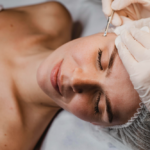Are you considering dermal fillers? If so, there are a few things you should know before getting started. In this blog post, we will discuss the ten most important things to keep in mind when trying dermal fillers. We will cover everything from the different types of dermal fillers to the potential side effects. By the time you finish reading this post, you will be an expert on dermal fillers!
1. Dermal fillers are a type of cosmetic treatment that can be used to improve the appearance of your skin
Dermal fillers are a type of cosmetic treatment designed to improve the appearance of your skin. They can be used to plump up areas of your face that have lost volume due to aging, Fillers are also commonly used to improve the appearance of acne scars and other types of scarring.
2. They can be used to reduce the appearance of wrinkles and lines, as well as to add volume to certain areas of the face
Dermal fillers are a popular way to reduce the appearance of wrinkles and lines, as well as add volume to certain areas of the face. Fillers can be used to plump up the lips, smooth out laugh lines, improve the appearance of scars, and more. The results from dermal fillers are usually temporary, lasting anywhere from six months to two years. However, in some cases, the results can be permanent.
3. There are a variety of different types of dermal fillers available, each with its own benefits and drawbacks
There are a variety of different types of dermal fillers available, each with its own benefits and drawbacks. collagen injections, for example, are great for adding volume to the skin, while hyaluronic acid fillers are good for smoothing out wrinkles.
However, it is important to be aware that not all dermal fillers are created equal. Some products may cause adverse reactions or look unnatural once injected. So it is always important to do your research before choosing a filler and to consult with a qualified professional who can help you choose the best option for you.
4. Dermal fillers are a popular treatment option, but it is important to do your research before choosing a provider
Dermal fillers are a popular treatment option, but it is important to do your research before choosing a provider. Make sure to ask about the provider’s experience with the type of filler you are interested in, and find out what kind of training they have had in injecting dermal fillers. It is also important to be aware of the potential risks associated with dermal fillers.
5. Dermal fillers should only be administered by a qualified medical professional
Dermal fillers are a type of injectable cosmetic treatment that can be used to reduce the appearance of wrinkles and lines and to improve the overall contour of the face. As with any medical procedure, dermal filler injections should only be administered by a qualified medical professional.
6. The results of dermal filler treatment can vary from person to person
Dermal filler treatment can vary depending on the person’s age, skin type, how much sun they have been exposed to, where the injection is placed, and how many injections they have had. The results can also last anywhere from 4 months to 2 years.
7. It is important to discuss your desired outcome with your doctor before undergoing treatment
It is very important to discuss your desired outcome with your doctor before undergoing treatment. This will help them to choose the filler that is best suited for you and can help to ensure that you are happy with the results.
8. Make sure you understand the risks associated with dermal fillers and how to minimize them
Like all types of surgery, dermal filler procedures carry some risks. The most common risks include bruising, swelling, and redness at the injection site. In rare cases, adverse reactions such as itching, hives, or rash may occur. You can minimize the risk of these unwanted effects by choosing a qualified and experienced doctor to perform your procedure.
9. Follow all post-treatment instructions carefully to ensure optimal results
Following post-treatment instructions is crucial to ensure optimal results with dermal fillers. Some general guidelines to keep in mind include:
1) avoid sun exposure and UV radiation for at least 24 hours after treatment;
2) avoid strenuous activity or exercise for at least 24 hours after treatment;
3) avoid alcohol consumption for at least 24 hours after treatment; and
4) avoid placing any pressure on the treated area for at least 12 hours after treatment.
10. Dermal filler injections can be painful, so numbing cream may be applied beforehand
This will help to numb the area and make the injection process much more tolerable. Of course, everyone’s pain tolerance is different so you may still feel some discomfort even with numbing cream applied. But it will definitely help!







